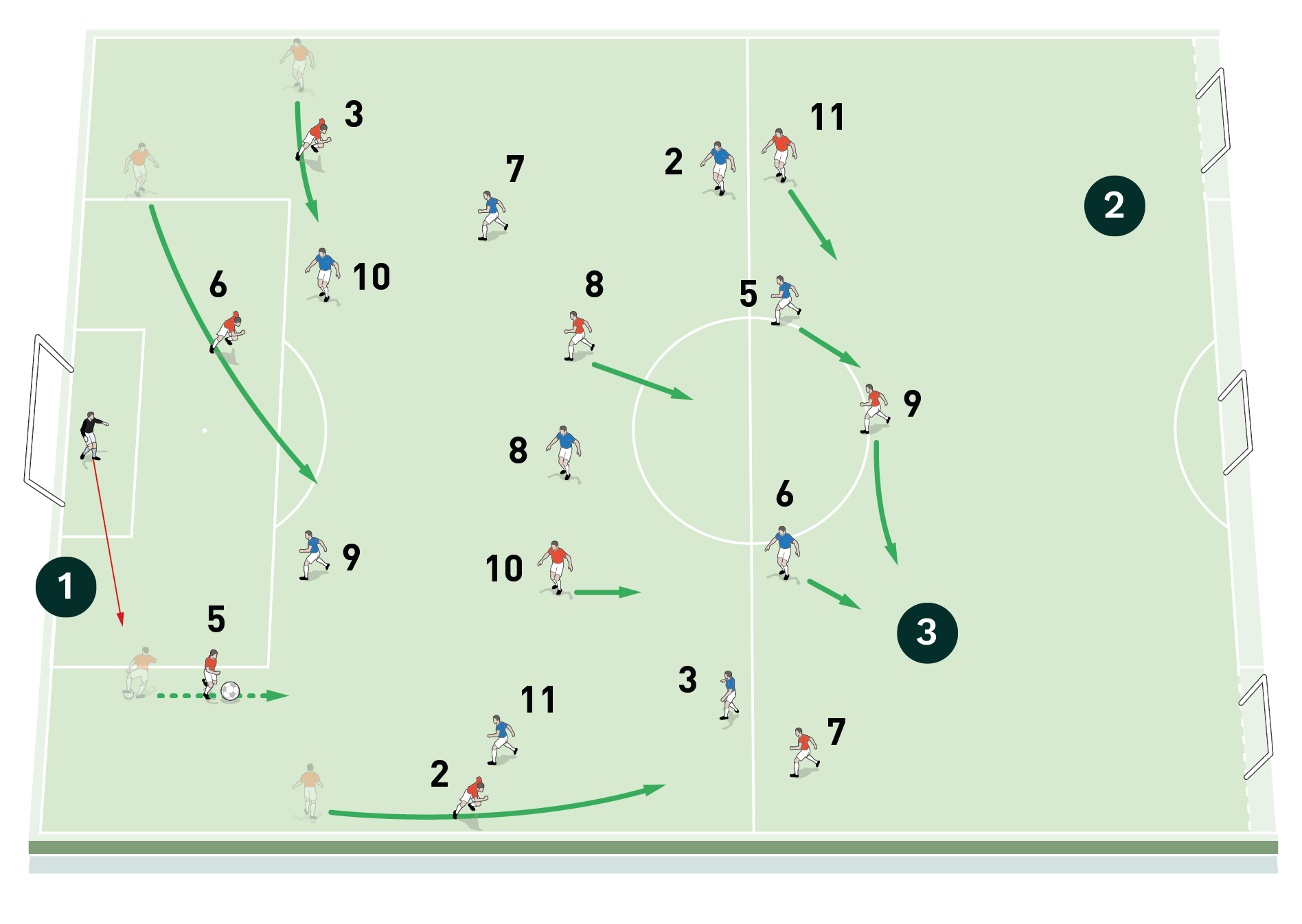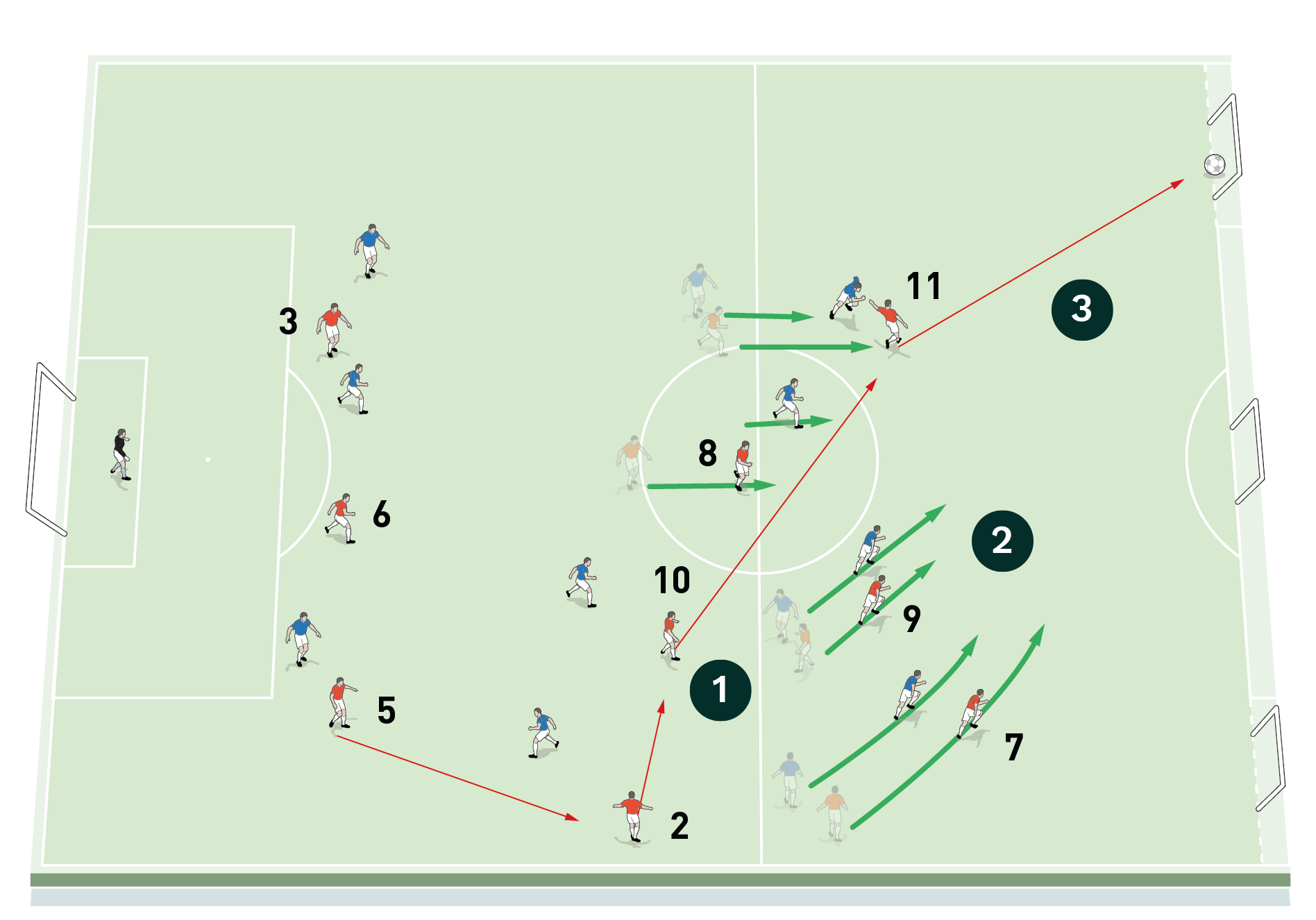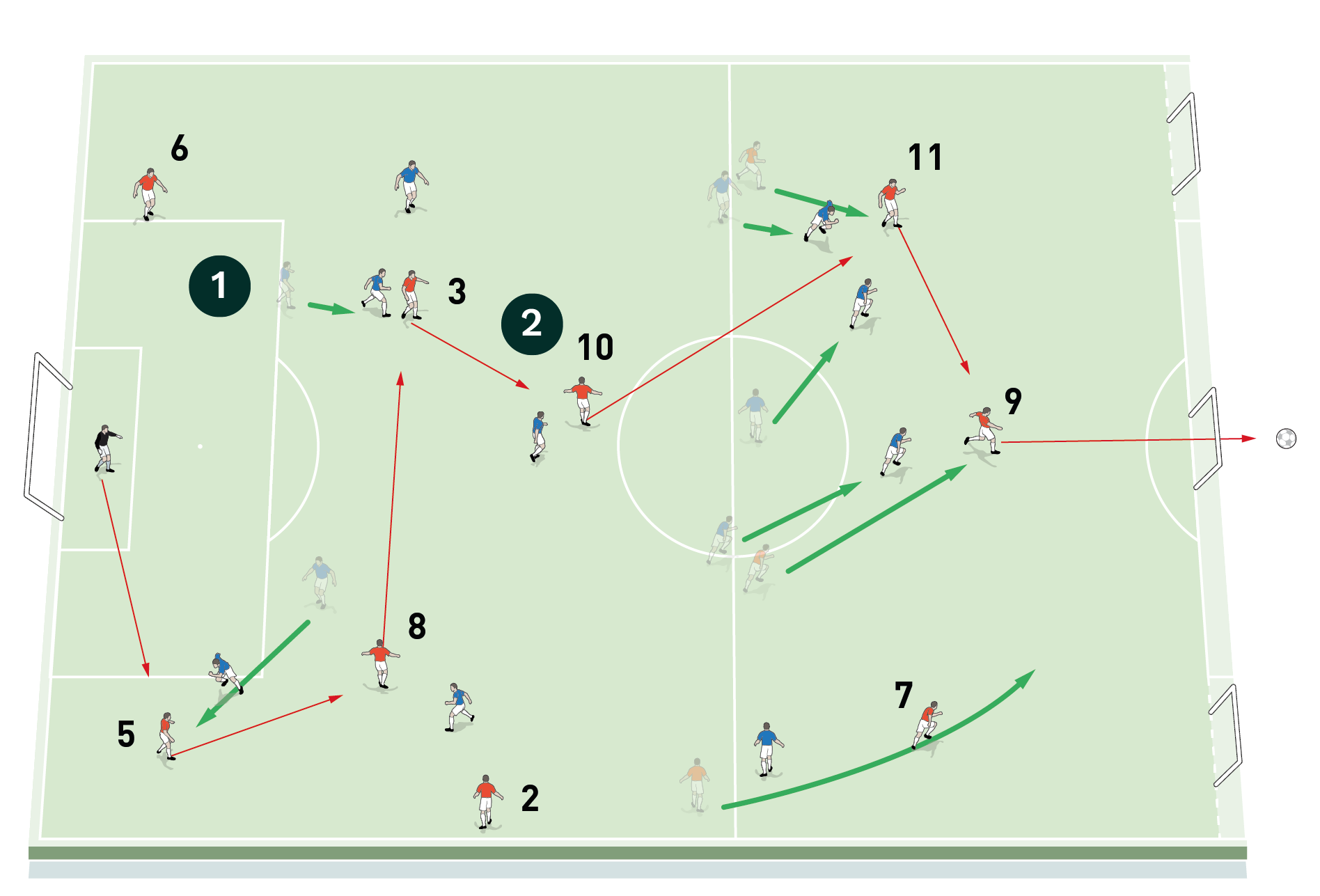Playing forward from the defensive third

| Area | Three quarters of pitch |
| Equipment | Balls, bibs, cones, 1 full size goal, 3 small goals |
| No. of Players | 18 players + 1 goalkeeper |
| Session Time | Session: 30mins |
This session is aimed at developing a team’s decision making in possession when playing against an opposition that press high. The session is set up as a phase of play, using three quarters of a pitch, and involving at least two full units of two teams – for example, the 4-4 part of a 4-4-2 versus the 3-3 part of a 4-3-3. However, the closer the team organisation looks to the 11v11 game, the better for the realism of the practice.
Playing out short against a high press is a common theme in both development and performance football and it is this trend that can sometimes override a rational approach to restarts from the goalkeeper when in possession of the ball in the defensive third, with teams at both development and performance level playing out from the back at every opportunity, even when the opposition is set up to press high. Whilst it is important to develop well rounded players capable of receiving and playing under pressure, it is as important to develop decision making and an understanding of how and when to play forward, and to balance risk and reward.
This session aims to develop all of the opportunities to play forward that a team has when building possession from the defensive third, linking the purpose of having possession of the ball to the outcomes on the pitch – playing forward and creating scoring opportunities. This session challenges players to embrace the significance of varying their build-up play, particularly when some players and teams are reluctant to play longer passes, or to play and run to spaces in-behind the opposition, or to take a more direct approach to their play.
The session also gives the coaching team the opportunity to coach principles of play both in and out of possession. Working as a coaching pair to ‘cancel each other out’ is a good way to create challenges and realism in the session (with one coach working with the team playing forward and the other coach working with the pressing team), and ultimately to create an environment that stresses the players’ decision making and tactical awareness.
Setting the session up with a scenario also adds to the returns and can help achieve different outcomes. For example, the attacking team is 1-0 up, or the attacking team is 2-0 down. Doing so asks the players to link the state of the game to their decision making with the ball as a team or unit, and ultimately to strive for the desired outcome with the ball; creating a chance to score and/or minimising the risk of conceding a goal in a counter-attack.
DECISION MAKING WHEN PLAYING OUT FROM THE BACK
We set up on three quarters of a pitch with a goal and goalkeeper at one end and three small goals at the other end. We’re using 18 outfield players. The attacking red team has the goalkeeper and is set up with a back four, two midfield players and a front three. The blue defending team is set up with a back four, three midfield players and a front two. This organisation gives the coaches the opportunity to work with teams linked to both 4-4-2 and 4-3-3 formations.
The session set-up is simple and has the aim of replicating the game as closely as possible. The session starts with the red goalkeeper taking a goal kick, as shown [1a]. The aim for the red team is to build up play and score in one of the three small goals, while the aim for the blue team is to win possession of the ball and score in the main goal.
In this example, let’s say the attacking team (the reds) are 2-0 down with 30 minutes remaining. Setting this scenario will create a sense of urgency amongst the red team, encouraging them to create as many opportunities to score in the small goals as possible, with the blues working harder to defend their lead and create counter-attacking opportunities.
Coaching the principles of play to the team in possession.
With the attacking team (the reds) 2-0 down and not in control of the game, it is their aim to gain control of the momentum and to maximise the opportunities they have to score, and of course to avoid conceding a third goal. The emphasis is therefore on their decision making and the outcomes with the ball.
[1a]

2. The aim for the red attacking team is to score in one of the three small goals
3. The aim for the blue defending team is to win possession of the ball and counter-attack the main goal
“The session allows the coach to develop decision making and to give technical and tactical detail linked to playing forward from the defensive third”
[1b]

2. In this phase of play, the red front six have an overload against a blue back five
3. The players must play quickly and effectively, using longer passes to make use of the overload up front and get in behind the defenders
The coach working with the opposition blue team will highlight the importance of regaining the ball, and therefore the blues are likely to make one of two decisions: to press high in the hope of regaining the ball around the goal, or to drop off and look to counter-attack from deeper in the pitch. This is where the session now allows the coach of the reds to develop decision making and to give technical and tactical detail linked to playing forward from the defensive third. The reds will either have space to play in front of or in behind the blue team, and the outcomes of their decisions here will likely affect the overall outcome of the session and the game scenario.
Creating the opportunity to play forward against a high press.
Balancing risk and reward here is important for the red players, and so is the team shape. The reds should create support for the ball and different options to play forward from the goalkeeper, and/or the player in possession. In the diagram [1b], the red team stretch the pitch to create height, width and depth, creating as much space as possible, therefore giving the blue team a bigger area to defend, and importantly, giving the red goalkeeper options to play short, long, wide and central.
Creating and playing into an overload.
Now that the red team have stretched the pitch, they have the opportunity to play short and long. The key here is for the goalkeeper (or player in possession of the ball) to identify the overload – a red front six against a blue back five, as shown [1b], or a red back six against a blue front four, as shown [1c], and to play quickly and effectively into that area of the pitch.
Playing to the space in-behind.
Whether the team has played short or long, the emphasis must now be on playing away from pressure and into space. This is often either between the lines, or in-behind. Playing and running in-behind from the defensive/midfield third is an effective way of stretching the pitch; causing the opposition to drop deeper and creating spaces/passes between the lines, all helping to create time on the ball and opportunities to play forward, bypassing the press. Challenging the players’ decision making as to when they play short, to feet and in front of the opposition press, rather than looking to play and run forward and into space here is important. Passes through the pitch/opposition and into space will have massive benefits when playing against a high press in forcing the opposition to drop deeper and/or recover to defend their goal.
The red team’s number 7, number 9 and number 11 have a responsibility to hold their positions, creating height and width, and with well-timed movement and forward passes, to create opportunities to receive in behind. The number 8 also has the responsibility to run forward to create an overload in support of the ball. It’s important here to also coach the actions of the red backline once the ball has been played forward, making sure that they ‘play-up, move-up, close-up’!
[1c]

2. The red back six are playing against a blue front four and must recognise this as an opportunity to pass short, using the space between the lines to get forwards and beat the high press
“For this session to be successful, players must be comfortable playing and receiving under pressure”
COACHING POINTS
How do I progress the session?
Good players will quickly recognise how to beat the session and find ways to create success under the conditions. It is the coach’s responsibility to continue to challenge players and stress their decision making, linked to the state of the game.
Players may also switch off from the theme and potentially resist the need to be more direct in their play and run in behind, or to sit off and not press with match intensity, as this is physically challenging. The coach should encourage players to stay engaged with the theme, the scenario and their specific technical/tactical responsibilities within the session. The coach should look for opportunities to positively reinforce good decisions/actions and to give feedback/instruction when the players don’t achieve the desired outcomes.
What are the key things to look for?
Both teams will need to have a good understanding of the basic attacking and defending principles of play, as well as good technically ability. This is a tactical practice, and therefore isn’t the type of session that creates opportunities for much technical development. That will occur in the lead-in session or throughout the remainder of the training week. For this session to be successful, players must be comfortable playing and receiving under pressure, with the ability to turn, play forward and play a variety of short and longer passes.
What are the typical mistakes players might make and how do I avoid them?
Undoubtedly players will over-play, complicate things and take too many touches. Of course, there are times in a game when it is appropriate to stay on the ball and put passes together, but this isn’t that type of session. Ideally, the red team will create lots of opportunities to score in the three small goals. The likelihood is that they won’t achieve this by playing slowly and overcomplicating their play if the opposition are pressing effectively.
How long does the session last?
This is the type of session that can’t be rushed. Trying to improve tactical awareness and to get the optimum repetition of decision making takes time. It’s worth allocating at least 30 minutes to this session. Giving the session a bit of time to develop is important. It may not be until later in the session that the best learning takes place, when the session finds a natural ebb and flow, and both teams have chance to settle in to the scenario.
Editor's Picks
Attacking transitions
Jesse Marsch
Deep runs in the final third
Fabian Hürzeler
Using the goalkeeper in build-up play
Ralph Hasenhüttl
Intensive boxes drill with goals
Andoni Iraola
Penetrating the final third
Ange Postecoglou
Creating and finishing
Pep Guardiola
My philosophy
Sir Alex Ferguson
Pressing initiation
Mauricio Pochettino
Compact team movement
Roberto Martinez
Coaches' Testimonials

Alan Pardew

Arsène Wenger

Brendan Rodgers

Carlos Carvalhal

José Mourinho

Jürgen Klopp

Pep Guardiola

Roy Hodgson

Sir Alex Ferguson

Steven Gerrard
Coaches' Testimonials

Gerald Kearney, Downtown Las Vegas Soccer Club

Paul Butler, Florida, USA

Rick Shields, Springboro, USA

Tony Green, Pierrefonds Titans, Quebec, Canada
Join the world's leading coaches and managers and discover for yourself one of the best kept secrets in coaching. No other training tool on the planet is written or read by the calibre of names you’ll find in Elite Soccer.
In a recent survey 92% of subscribers said Elite Soccer makes them more confident, 89% said it makes them a more effective coach and 91% said it makes them more inspired.
Get Monthly Inspiration
All the latest techniques and approaches
Since 2010 Elite Soccer has given subscribers exclusive insight into the training ground practices of the world’s best coaches. Published in partnership with the League Managers Association we have unparalleled access to the leading lights in the English leagues, as well as a host of international managers.
Elite Soccer exclusively features sessions written by the coaches themselves. There are no observed sessions and no sessions “in the style of”, just first-hand advice delivered direct to you from the coach.









